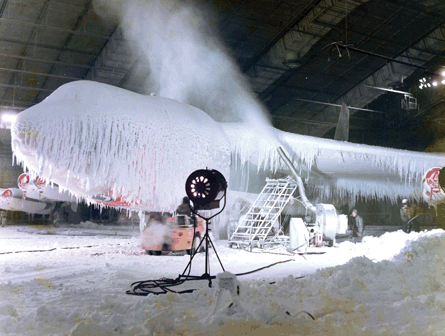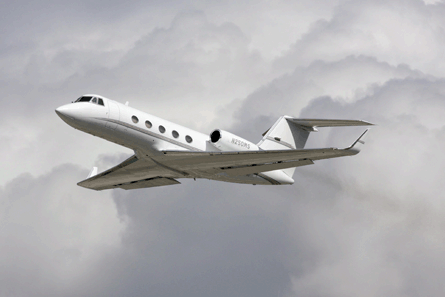US engine manufacturers will soon have to run an icier gauntlet when ground testing their next-generation turbofans for certification. While bird strikes and blade-outs tend to grab the most attention when turbofans are designed and put through their paces, handling ice build-up and ingestion is no small feat - and one which will soon get tougher.
Under new US Federal Aviation Administration Part 33 engine certification rules - set to go live in 2012 - the test regime for induction icing will be expanded. Part 33 will include exposure to supercooled large droplets (drops of freezing rain), ice crystals (a high-altitude phenomena) and procedures for extended hold-over times, to simulate long tarmac waits in foggy winter weather. As with all engine tests, to pass muster the turbofan must stay within power and temperature bounds and cannot stall, surge, flameout or rollback when ice on the induction system gets sucked into the engine. Similarly, ice slugs must not damage the engine either, by bending blades or vanes.
Engines are certified at the component level first (Part 33) and then at the aircraft level under Part 25 (transport aircraft certification) rules. Part 33 is considered to be the more rigorous of the two. For icing certification, manufacturers first define an operating environment for the engine. The next stage is to use Part 33 and FAA advisory circular guidance to determine the liquid water content, droplet size and temperature ranges the engine should be exposed to in ground testing.
 |
|---|
© USAFThe McKinley Climatic Laboratory at Eglin AFB serves as an icing test facility |
Tom Bond, FAA chief scientist and technical advisor for flight environmental icing, says the companies develop a "critical point analysis", which determines the most stressful operating conditions. This then becomes part of a test plan, that ultimately will include 15-20 test points. "Once they get an approved test plan [from the FAA], they run the engine at a sea level or altitude facility, where they generate an icing cloud and operate the engine at various conditions," Bond says. He adds that the new rule will pose "different conditions" the manufacturers will have to assess.
Jim MacLeod, group leader for environment and certification testing at the Canadian National Research Council's (NRC) gas turbine laboratory, says NRC allots 4-6 weeks for a Part 33 icing test. NRC, working with Rolls-Royce and Pratt & Whitney, recently opened a new two-stand direct-connect outdoor turbofan engine natural icing facility in Manitoba, Canada - one of only a handful of Part 33 icing facilities in North America.
This year NRC tested its large turbofan stand using a Rolls-Royce Trent 900, and its smaller stand with Pratt & Whitney's PW1524G, the geared turbofan for Bombardier's CSeries regional jet. The first official Part 33 icing test will take place later this year, with the Rolls-Royce Trent XWB engine for the Airbus A350.
Other icing test facilities in North America include the Arnold Engineering Development Center in Tennessee, the McKinley Climatic Laboratory at Eglin AFB in Florida and GE Canada's icing center in Manitoba.
UNDER THE WEATHER
Though each test point takes roughly 10min to 1h to perform, waiting for the right weather at NRC's outdoor global aerospace center for icing and environment research can take time. NRC uses the natural weather and spray masts to create the icing conditions. Thompson, Manitoba, has two icing test seasons per year for the typical -2°C (28°F) to -20°C testing range - October-November and March-April. January is too cold for ice, but serves as a good month to test engine cold-start performance.
Along with the set test points - which require a quick throttle-up after dwelling at the test point, to throw any accumulated ice into the engine and see the effects - there are also "engineering points". At these moments, instead of throttling-up, the engine is shut down to take pictures and samples of the ice. "We have to show airworthiness officials what the points were, and that models were accurate with reality," MacLeod adds.
The icing portion of an engine certification typically takes place late in the programme, leaving little flexibility for schedule changes if problems are found. "Icing oftentimes is left to 'cross your fingers and hope for the best'", MacLeod says. "[Engine makers] usually do this after bird ingestion and blade-off tests, when the design is pretty much cast in stone. In the past, when an engine was five years in development there were lots of opportunities to tweak and test again. Now with 18-24 month development times, there's not enough opportunity to carry out a number of tests."
 |
|---|
©AirTeamImages.comA Gulfstream II is to be used in upcoming tests |
First published in June 2010, the Part 33 engine icing amendments are part of a broader package aiming to address decades-old airframe and engine icing certification, in the wake of key accidents and incidents. The fatal 1994 crash of an American Eagle ATR 72 in Indiana had a particular influence on the amendments. The US National Transportation Safety Board surmised that supercooled large droplets created a clear ice ridge behind the deicing boots and ahead of the ailerons. This led to an uncommanded roll, from which the pilots could not recover.
Supercooled large droplets can be 10- to 100-times larger in diameter than the typical freezing raindrop sizes tested today. The issue affects engines as well as airframes. While engines may have inlet, spinner and guide vane heating, ice can still form on various surfaces - particularly during long waits at idle power. This build-up threatens to break off and flow into the engine when throttling up to move or at take-off. When ingestion occurs the ice flashes to steam in the compressor core, this can then cause a stall or other problems.
Along with the larger droplet sizes, the revised Part 33 rules will also require manufacturers to prove that engine designs can handle falling and blowing snow and, more importantly, ice crystals. This high-altitude phenomenon has become a topic of increasing concern - NASA says that since 1989 there have been nearly 100 cases of turbofan power problems at high altitude. The administration, along with Transport Canada and other groups, is seeking to better define ice crystal testing criteria by using a specially-equipped Gulfstream II in two flight campaigns in Australia in 2012 and 2013. The FAA plans to update the ice crystal certification requirements going into effect next year by 2015, based on the flight test data. The new rules will also address a growing problem on the apron, where long wait times and crowded take-off queues - combined with efficient, heat-conserving engines - are cause for concern. While engine manufacturers currently have to demonstrate an engine can withstand 30min of idling in icing conditions, Part 33 will add a requirement to develop an engine run-up procedure for the aircraft manual
"If you have to run up to 60-70% [to clear ice], that can be detrimental to aircraft [following]," says John Fisher, an aerospace engineer for the FAA's engine and propeller directorate, adding that some manufacturers are adding anti-ice systems to engine components, to allow for a longer idling time.
MacLeod says requests to prove out engine operations during long idling periods are coming from airlines. "In the past they would have only done a ground fog test for 30-60min, where the engine would idle for 30min, followed by a throttle movement to shed the ice, then return down to idle," he says. "For large planes now, there's so much thrust that goosing the throttle would cause sliding or blowing ice on aircraft behind them. Now they're saying the engine has to accumulate ice for one or two hours, with no throttle-up in the middle."
Fisher says there are cases where manufacturers have not been able to demonstrate the ability to handle "long term" idling in ground fog. "Some have to return to the gate if they are unsuccessful in running up to a specified power level by a certain time," he says.
Source: Flight International
















